Comprehensive Report: Office Management, Leadership, & Presentation
VerifiedAdded on 2020/06/06
|16
|5115
|75
Report
AI Summary
This report provides a comprehensive overview of office management, leadership, and presentation skills. It covers best practices in developing presentations, including audience considerations and communication media advantages and limitations. The report also addresses managing office facilities, including establishing procedures, managing work effectiveness, and designing office systems. Additionally, it delves into handling mail, including dealing with junk mail, addressing problems with mail, and organizational policies. Furthermore, the report explores administrative support for meetings, spreadsheet software, and email usage. Finally, it examines principles of leadership and management, including planning, coordinating, controlling work, and key performance indicators. The report incorporates multiple units such as developing a presentation, managing office facilities, handling mail, providing administrative support for meetings, spreadsheet software, using e-mail, and principles of leadership and management.

Paraphrase This Document
Need a fresh take? Get an instant paraphrase of this document with our AI Paraphraser

Table of Contents
UNIT 10 DEVELOP A PRESENTATION.....................................................................................4
1.1 Best practices in developing presentation.............................................................................4
1.2 Who needs to be consulted on developing a presentation.....................................................4
1.3 Explain the factors to be taken into account in developing a presentation ..........................4
1.4 Advantages and limitations of communication media..........................................................4
2.1 Identify the purpose, content, style, timing and audience for a presentation........................5
UNIT 11 MANAGE OFFICE FACILITY......................................................................................5
1.1 Explain the requirements of establishing and implementing office management procedures
.....................................................................................................................................................5
1.2 Explain how to manage the effectiveness of work and systems...........................................5
1.4 Explain the factors to be taken into account in the design of office systems, procedures
and guidance documents.............................................................................................................6
UNIT 19 HANDLE MAIL..............................................................................................................6
1.1 How to deal with junk mail...................................................................................................6
1.2 Problems arising with incoming or outgoing of mail............................................................7
1.3 Operate a franking machine..................................................................................................7
1.4 Preparation of package for distribution................................................................................7
1.5 State organisational policies and procedure on handling of mail.........................................7
1.6 Process for reporting suspicious and damaged items............................................................8
3.2 Best option for dispatching mail according to the required degree of urgency....................8
UNIT 21 PROVIDE ADMINISTRATIVE SUPPORT FOR MEETING.......................................8
1.1 Purpose of meeting and need to attend.................................................................................8
1.2 Important to have minimum number of attendees for meeting............................................8
1.3 Ways to achieve maximum attendance at meeting..............................................................9
1.4 The access, health, safety and security requirements related to meeting..............................9
1.5 The resources to set up need for meeting.............................................................................9
1.6 Responsibilities of meeting chair and meeting secretary......................................................9
UNIT 10 DEVELOP A PRESENTATION.....................................................................................4
1.1 Best practices in developing presentation.............................................................................4
1.2 Who needs to be consulted on developing a presentation.....................................................4
1.3 Explain the factors to be taken into account in developing a presentation ..........................4
1.4 Advantages and limitations of communication media..........................................................4
2.1 Identify the purpose, content, style, timing and audience for a presentation........................5
UNIT 11 MANAGE OFFICE FACILITY......................................................................................5
1.1 Explain the requirements of establishing and implementing office management procedures
.....................................................................................................................................................5
1.2 Explain how to manage the effectiveness of work and systems...........................................5
1.4 Explain the factors to be taken into account in the design of office systems, procedures
and guidance documents.............................................................................................................6
UNIT 19 HANDLE MAIL..............................................................................................................6
1.1 How to deal with junk mail...................................................................................................6
1.2 Problems arising with incoming or outgoing of mail............................................................7
1.3 Operate a franking machine..................................................................................................7
1.4 Preparation of package for distribution................................................................................7
1.5 State organisational policies and procedure on handling of mail.........................................7
1.6 Process for reporting suspicious and damaged items............................................................8
3.2 Best option for dispatching mail according to the required degree of urgency....................8
UNIT 21 PROVIDE ADMINISTRATIVE SUPPORT FOR MEETING.......................................8
1.1 Purpose of meeting and need to attend.................................................................................8
1.2 Important to have minimum number of attendees for meeting............................................8
1.3 Ways to achieve maximum attendance at meeting..............................................................9
1.4 The access, health, safety and security requirements related to meeting..............................9
1.5 The resources to set up need for meeting.............................................................................9
1.6 Responsibilities of meeting chair and meeting secretary......................................................9
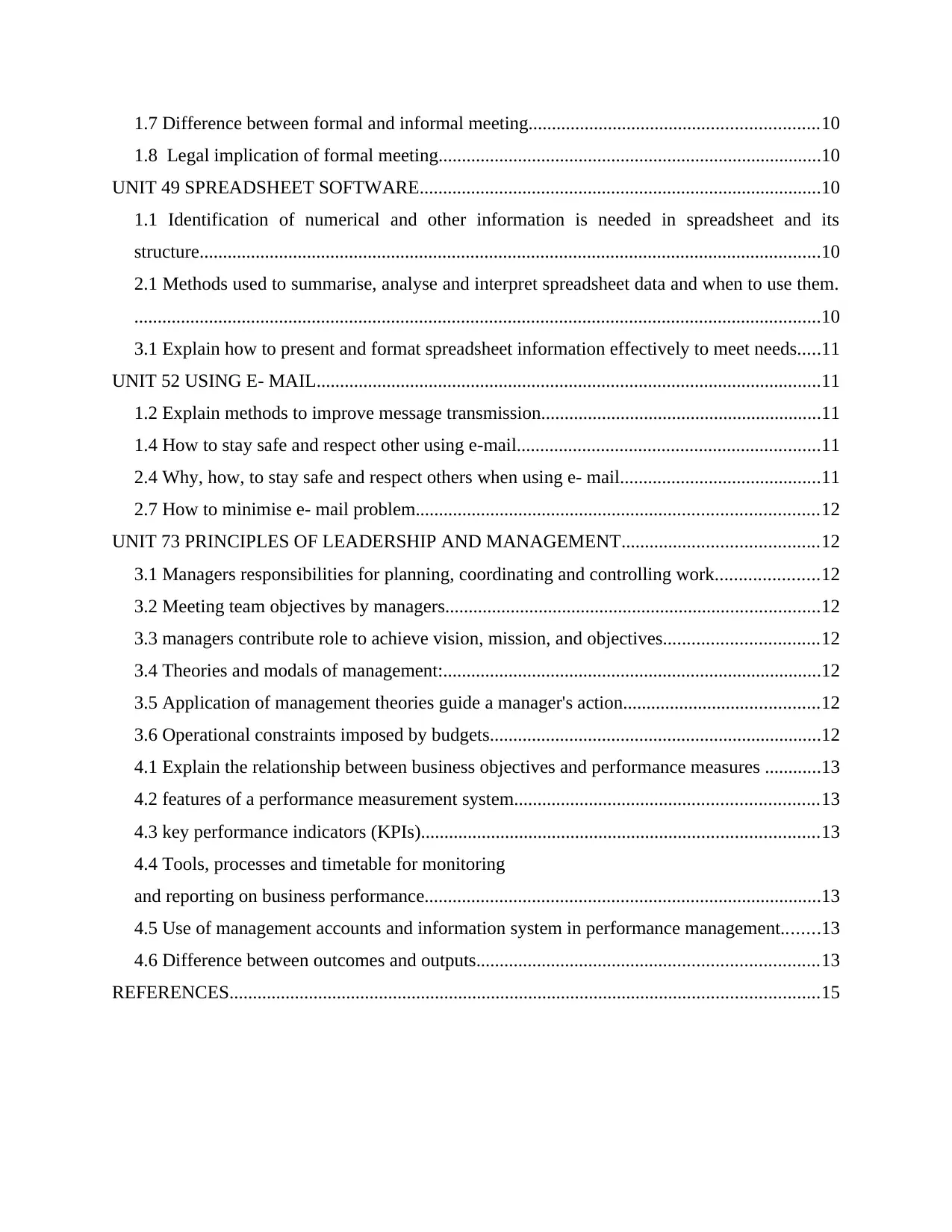
1.7 Difference between formal and informal meeting..............................................................10
1.8 Legal implication of formal meeting..................................................................................10
UNIT 49 SPREADSHEET SOFTWARE......................................................................................10
1.1 Identification of numerical and other information is needed in spreadsheet and its
structure.....................................................................................................................................10
2.1 Methods used to summarise, analyse and interpret spreadsheet data and when to use them.
...................................................................................................................................................10
3.1 Explain how to present and format spreadsheet information effectively to meet needs.....11
UNIT 52 USING E- MAIL............................................................................................................11
1.2 Explain methods to improve message transmission............................................................11
1.4 How to stay safe and respect other using e-mail.................................................................11
2.4 Why, how, to stay safe and respect others when using e- mail...........................................11
2.7 How to minimise e- mail problem......................................................................................12
UNIT 73 PRINCIPLES OF LEADERSHIP AND MANAGEMENT..........................................12
3.1 Managers responsibilities for planning, coordinating and controlling work......................12
3.2 Meeting team objectives by managers................................................................................12
3.3 managers contribute role to achieve vision, mission, and objectives.................................12
3.4 Theories and modals of management:.................................................................................12
3.5 Application of management theories guide a manager's action..........................................12
3.6 Operational constraints imposed by budgets.......................................................................12
4.1 Explain the relationship between business objectives and performance measures ............13
4.2 features of a performance measurement system.................................................................13
4.3 key performance indicators (KPIs).....................................................................................13
4.4 Tools, processes and timetable for monitoring
and reporting on business performance.....................................................................................13
4.5 Use of management accounts and information system in performance management........13
4.6 Difference between outcomes and outputs.........................................................................13
REFERENCES..............................................................................................................................15
1.8 Legal implication of formal meeting..................................................................................10
UNIT 49 SPREADSHEET SOFTWARE......................................................................................10
1.1 Identification of numerical and other information is needed in spreadsheet and its
structure.....................................................................................................................................10
2.1 Methods used to summarise, analyse and interpret spreadsheet data and when to use them.
...................................................................................................................................................10
3.1 Explain how to present and format spreadsheet information effectively to meet needs.....11
UNIT 52 USING E- MAIL............................................................................................................11
1.2 Explain methods to improve message transmission............................................................11
1.4 How to stay safe and respect other using e-mail.................................................................11
2.4 Why, how, to stay safe and respect others when using e- mail...........................................11
2.7 How to minimise e- mail problem......................................................................................12
UNIT 73 PRINCIPLES OF LEADERSHIP AND MANAGEMENT..........................................12
3.1 Managers responsibilities for planning, coordinating and controlling work......................12
3.2 Meeting team objectives by managers................................................................................12
3.3 managers contribute role to achieve vision, mission, and objectives.................................12
3.4 Theories and modals of management:.................................................................................12
3.5 Application of management theories guide a manager's action..........................................12
3.6 Operational constraints imposed by budgets.......................................................................12
4.1 Explain the relationship between business objectives and performance measures ............13
4.2 features of a performance measurement system.................................................................13
4.3 key performance indicators (KPIs).....................................................................................13
4.4 Tools, processes and timetable for monitoring
and reporting on business performance.....................................................................................13
4.5 Use of management accounts and information system in performance management........13
4.6 Difference between outcomes and outputs.........................................................................13
REFERENCES..............................................................................................................................15
⊘ This is a preview!⊘
Do you want full access?
Subscribe today to unlock all pages.

Trusted by 1+ million students worldwide
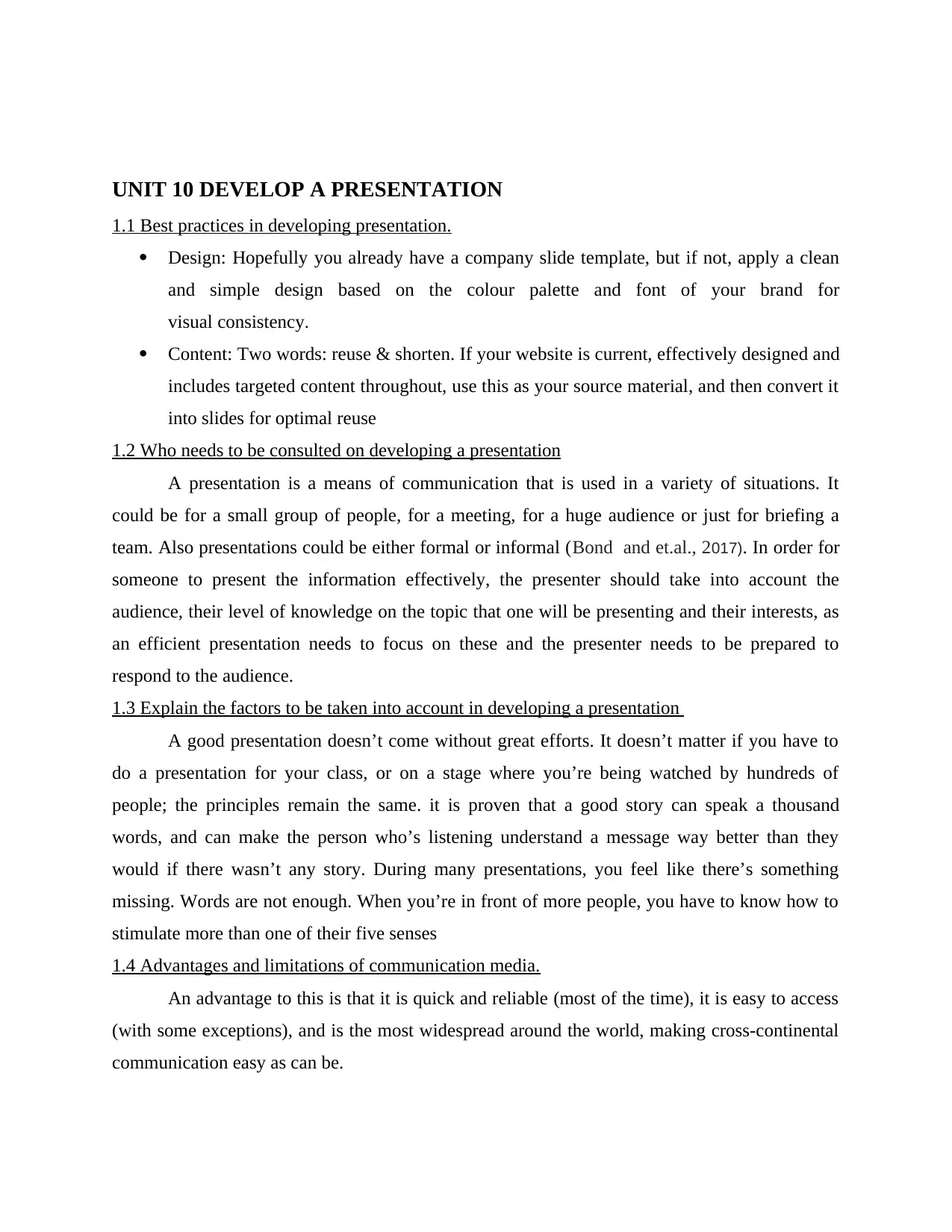
UNIT 10 DEVELOP A PRESENTATION
1.1 Best practices in developing presentation.
Design: Hopefully you already have a company slide template, but if not, apply a clean
and simple design based on the colour palette and font of your brand for
visual consistency.
Content: Two words: reuse & shorten. If your website is current, effectively designed and
includes targeted content throughout, use this as your source material, and then convert it
into slides for optimal reuse
1.2 Who needs to be consulted on developing a presentation
A presentation is a means of communication that is used in a variety of situations. It
could be for a small group of people, for a meeting, for a huge audience or just for briefing a
team. Also presentations could be either formal or informal (Bond and et.al., 2017). In order for
someone to present the information effectively, the presenter should take into account the
audience, their level of knowledge on the topic that one will be presenting and their interests, as
an efficient presentation needs to focus on these and the presenter needs to be prepared to
respond to the audience.
1.3 Explain the factors to be taken into account in developing a presentation
A good presentation doesn’t come without great efforts. It doesn’t matter if you have to
do a presentation for your class, or on a stage where you’re being watched by hundreds of
people; the principles remain the same. it is proven that a good story can speak a thousand
words, and can make the person who’s listening understand a message way better than they
would if there wasn’t any story. During many presentations, you feel like there’s something
missing. Words are not enough. When you’re in front of more people, you have to know how to
stimulate more than one of their five senses
1.4 Advantages and limitations of communication media.
An advantage to this is that it is quick and reliable (most of the time), it is easy to access
(with some exceptions), and is the most widespread around the world, making cross-continental
communication easy as can be.
1.1 Best practices in developing presentation.
Design: Hopefully you already have a company slide template, but if not, apply a clean
and simple design based on the colour palette and font of your brand for
visual consistency.
Content: Two words: reuse & shorten. If your website is current, effectively designed and
includes targeted content throughout, use this as your source material, and then convert it
into slides for optimal reuse
1.2 Who needs to be consulted on developing a presentation
A presentation is a means of communication that is used in a variety of situations. It
could be for a small group of people, for a meeting, for a huge audience or just for briefing a
team. Also presentations could be either formal or informal (Bond and et.al., 2017). In order for
someone to present the information effectively, the presenter should take into account the
audience, their level of knowledge on the topic that one will be presenting and their interests, as
an efficient presentation needs to focus on these and the presenter needs to be prepared to
respond to the audience.
1.3 Explain the factors to be taken into account in developing a presentation
A good presentation doesn’t come without great efforts. It doesn’t matter if you have to
do a presentation for your class, or on a stage where you’re being watched by hundreds of
people; the principles remain the same. it is proven that a good story can speak a thousand
words, and can make the person who’s listening understand a message way better than they
would if there wasn’t any story. During many presentations, you feel like there’s something
missing. Words are not enough. When you’re in front of more people, you have to know how to
stimulate more than one of their five senses
1.4 Advantages and limitations of communication media.
An advantage to this is that it is quick and reliable (most of the time), it is easy to access
(with some exceptions), and is the most widespread around the world, making cross-continental
communication easy as can be.
Paraphrase This Document
Need a fresh take? Get an instant paraphrase of this document with our AI Paraphraser

A disadvantage to this age, however, is the limitation to the access of technology some people,
and even some countries as a whole, have. It also poses a threat to hacking into the different
forms of communication since everything is sent through the internet or the airways.
2.1 Identify the purpose, content, style, timing and audience for a presentation
Paragraphs separate ideas into logical, manageable chunks. One paragraph focuses on
only one main idea and presents coherent sentences to support that one point. Because all the
sentences in one paragraph support the same point, a paragraph may stand on its own.
Three elements shape the content of each paragraph:
Purpose. The reason the writer composes the paragraph (Theobald, 2016).
Tone. The attitude the writer conveys about the paragraph’s subject.
Audience. The individual or group whom the writer intends to address.
UNIT 11 MANAGE OFFICE FACILITY
1.1 Explain the requirements of establishing and implementing office management procedures
Set up routines for handling paperwork and office systems. For instance, if possible,
every piece of paper that comes into your office should be handled once, acted upon, and filed –
not Haphazardly piled on a desk. Similarly, digital communications such as emails should be
Prioritized and acted upon immediately if possible or flagged for future action. Keeping records
Sounds like the easiest part of good office management – until you consider the need to keep
Those records both accessible and updated (Jensen and van der Voordt, 2016).
1.2 Explain how to manage the effectiveness of work and systems
Effective performance management enables employees and teams to understand the goals
of the organisation and to identify how individual and team outputs contribute to the
achievement of organisational objectives in line with organisational values. The integration of
people, planning and performance with organisational objectives develops individual, team and
organisational capability leading to higher performance. An effective performance management
process helps to establish and support the link between strategic business objectives and people's
day-to-day actions and tasks.
1.3 Explain how to manage any constraints attached to office facilities and related budgets
Each of your “customers” (i.e. each department, including facilities) has a certain portion
of your budget that they may use. The specific number is decided between you and each
individual department. For example, if you decide to treat facilities as a business, figuring out
and even some countries as a whole, have. It also poses a threat to hacking into the different
forms of communication since everything is sent through the internet or the airways.
2.1 Identify the purpose, content, style, timing and audience for a presentation
Paragraphs separate ideas into logical, manageable chunks. One paragraph focuses on
only one main idea and presents coherent sentences to support that one point. Because all the
sentences in one paragraph support the same point, a paragraph may stand on its own.
Three elements shape the content of each paragraph:
Purpose. The reason the writer composes the paragraph (Theobald, 2016).
Tone. The attitude the writer conveys about the paragraph’s subject.
Audience. The individual or group whom the writer intends to address.
UNIT 11 MANAGE OFFICE FACILITY
1.1 Explain the requirements of establishing and implementing office management procedures
Set up routines for handling paperwork and office systems. For instance, if possible,
every piece of paper that comes into your office should be handled once, acted upon, and filed –
not Haphazardly piled on a desk. Similarly, digital communications such as emails should be
Prioritized and acted upon immediately if possible or flagged for future action. Keeping records
Sounds like the easiest part of good office management – until you consider the need to keep
Those records both accessible and updated (Jensen and van der Voordt, 2016).
1.2 Explain how to manage the effectiveness of work and systems
Effective performance management enables employees and teams to understand the goals
of the organisation and to identify how individual and team outputs contribute to the
achievement of organisational objectives in line with organisational values. The integration of
people, planning and performance with organisational objectives develops individual, team and
organisational capability leading to higher performance. An effective performance management
process helps to establish and support the link between strategic business objectives and people's
day-to-day actions and tasks.
1.3 Explain how to manage any constraints attached to office facilities and related budgets
Each of your “customers” (i.e. each department, including facilities) has a certain portion
of your budget that they may use. The specific number is decided between you and each
individual department. For example, if you decide to treat facilities as a business, figuring out
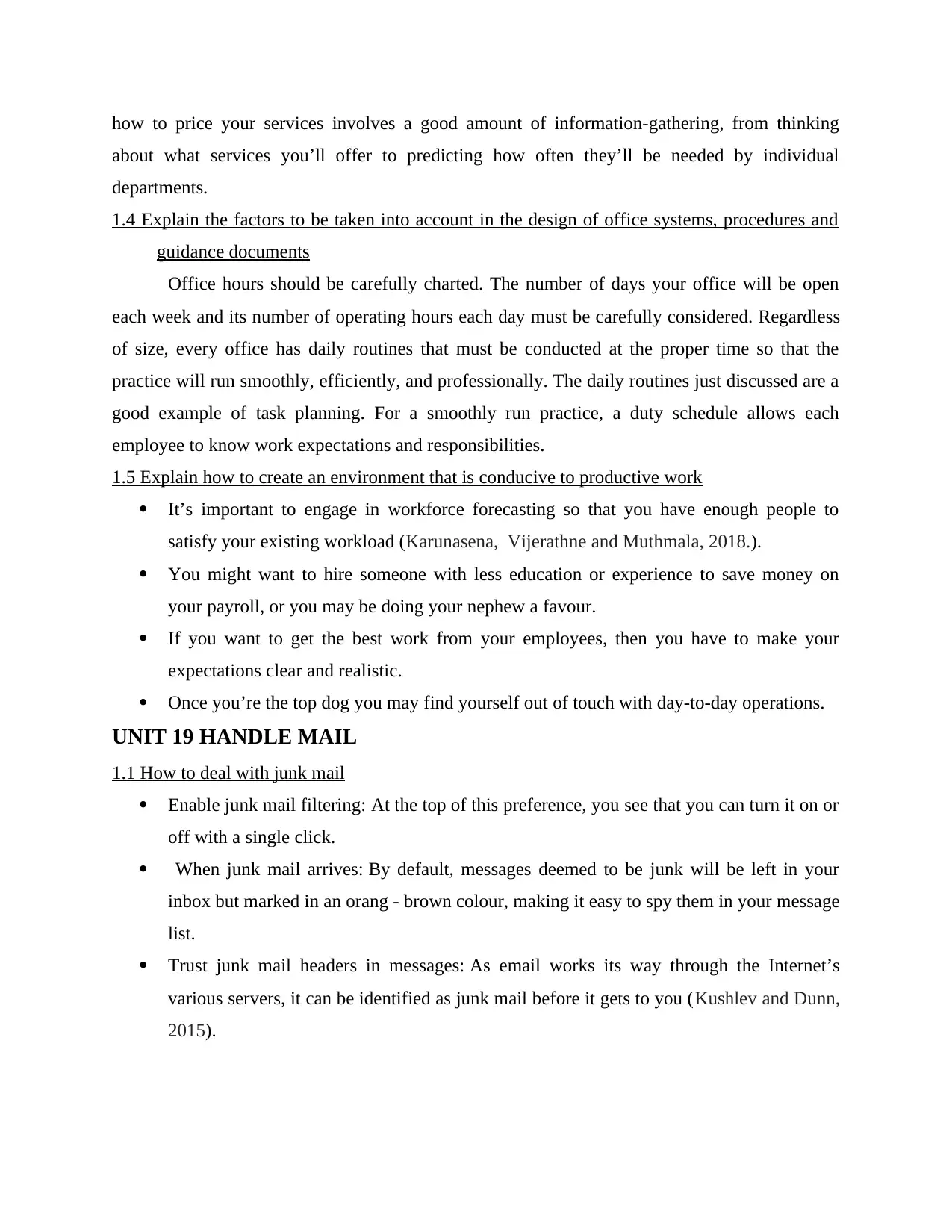
how to price your services involves a good amount of information-gathering, from thinking
about what services you’ll offer to predicting how often they’ll be needed by individual
departments.
1.4 Explain the factors to be taken into account in the design of office systems, procedures and
guidance documents
Office hours should be carefully charted. The number of days your office will be open
each week and its number of operating hours each day must be carefully considered. Regardless
of size, every office has daily routines that must be conducted at the proper time so that the
practice will run smoothly, efficiently, and professionally. The daily routines just discussed are a
good example of task planning. For a smoothly run practice, a duty schedule allows each
employee to know work expectations and responsibilities.
1.5 Explain how to create an environment that is conducive to productive work
It’s important to engage in workforce forecasting so that you have enough people to
satisfy your existing workload (Karunasena, Vijerathne and Muthmala, 2018.).
You might want to hire someone with less education or experience to save money on
your payroll, or you may be doing your nephew a favour.
If you want to get the best work from your employees, then you have to make your
expectations clear and realistic.
Once you’re the top dog you may find yourself out of touch with day-to-day operations.
UNIT 19 HANDLE MAIL
1.1 How to deal with junk mail
Enable junk mail filtering: At the top of this preference, you see that you can turn it on or
off with a single click.
When junk mail arrives: By default, messages deemed to be junk will be left in your
inbox but marked in an orang - brown colour, making it easy to spy them in your message
list.
Trust junk mail headers in messages: As email works its way through the Internet’s
various servers, it can be identified as junk mail before it gets to you (Kushlev and Dunn,
2015).
about what services you’ll offer to predicting how often they’ll be needed by individual
departments.
1.4 Explain the factors to be taken into account in the design of office systems, procedures and
guidance documents
Office hours should be carefully charted. The number of days your office will be open
each week and its number of operating hours each day must be carefully considered. Regardless
of size, every office has daily routines that must be conducted at the proper time so that the
practice will run smoothly, efficiently, and professionally. The daily routines just discussed are a
good example of task planning. For a smoothly run practice, a duty schedule allows each
employee to know work expectations and responsibilities.
1.5 Explain how to create an environment that is conducive to productive work
It’s important to engage in workforce forecasting so that you have enough people to
satisfy your existing workload (Karunasena, Vijerathne and Muthmala, 2018.).
You might want to hire someone with less education or experience to save money on
your payroll, or you may be doing your nephew a favour.
If you want to get the best work from your employees, then you have to make your
expectations clear and realistic.
Once you’re the top dog you may find yourself out of touch with day-to-day operations.
UNIT 19 HANDLE MAIL
1.1 How to deal with junk mail
Enable junk mail filtering: At the top of this preference, you see that you can turn it on or
off with a single click.
When junk mail arrives: By default, messages deemed to be junk will be left in your
inbox but marked in an orang - brown colour, making it easy to spy them in your message
list.
Trust junk mail headers in messages: As email works its way through the Internet’s
various servers, it can be identified as junk mail before it gets to you (Kushlev and Dunn,
2015).
⊘ This is a preview!⊘
Do you want full access?
Subscribe today to unlock all pages.

Trusted by 1+ million students worldwide
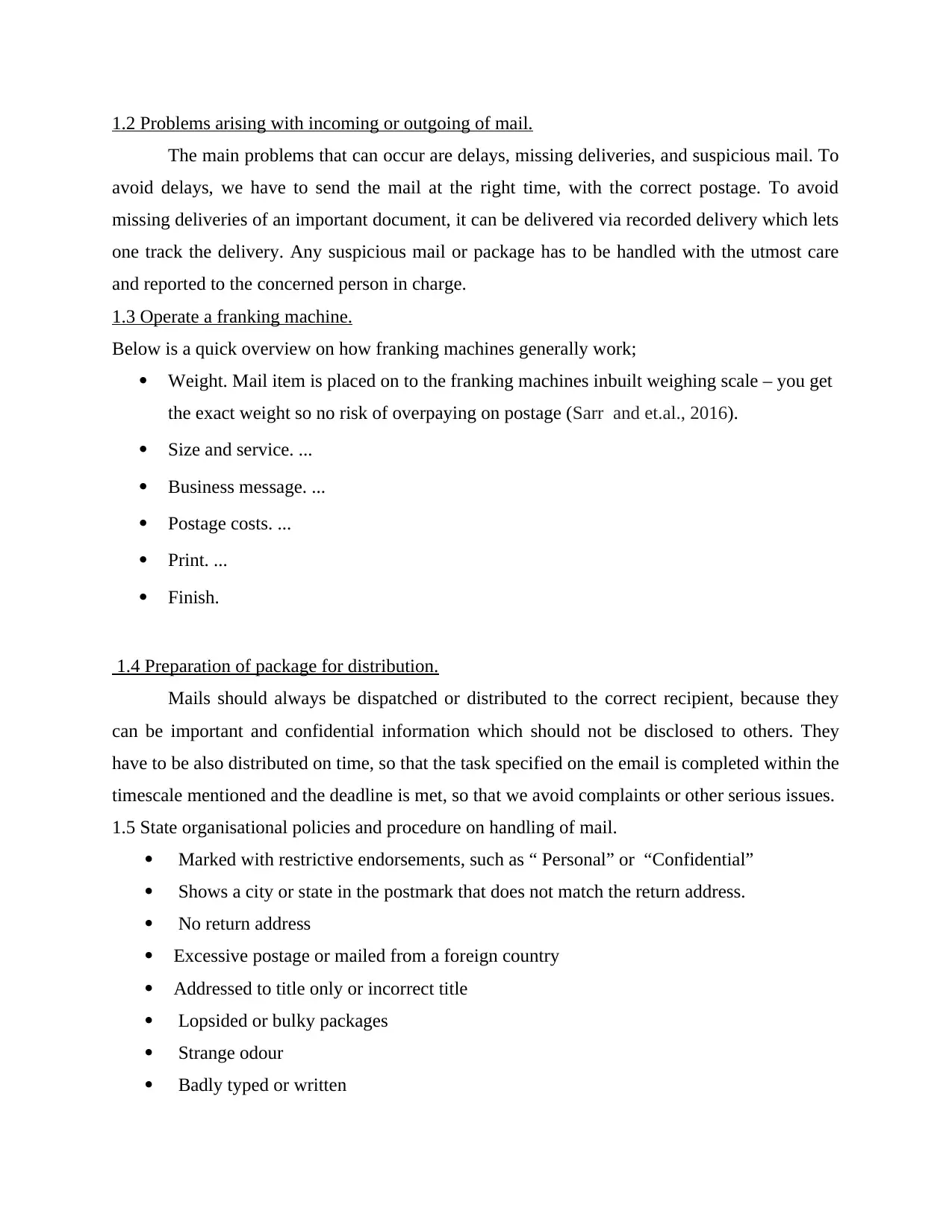
1.2 Problems arising with incoming or outgoing of mail.
The main problems that can occur are delays, missing deliveries, and suspicious mail. To
avoid delays, we have to send the mail at the right time, with the correct postage. To avoid
missing deliveries of an important document, it can be delivered via recorded delivery which lets
one track the delivery. Any suspicious mail or package has to be handled with the utmost care
and reported to the concerned person in charge.
1.3 Operate a franking machine.
Below is a quick overview on how franking machines generally work;
Weight. Mail item is placed on to the franking machines inbuilt weighing scale – you get
the exact weight so no risk of overpaying on postage (Sarr and et.al., 2016).
Size and service. ...
Business message. ...
Postage costs. ...
Print. ...
Finish.
1.4 Preparation of package for distribution.
Mails should always be dispatched or distributed to the correct recipient, because they
can be important and confidential information which should not be disclosed to others. They
have to be also distributed on time, so that the task specified on the email is completed within the
timescale mentioned and the deadline is met, so that we avoid complaints or other serious issues.
1.5 State organisational policies and procedure on handling of mail.
Marked with restrictive endorsements, such as “ Personal” or “Confidential”
Shows a city or state in the postmark that does not match the return address.
No return address
Excessive postage or mailed from a foreign country
Addressed to title only or incorrect title
Lopsided or bulky packages
Strange odour
Badly typed or written
The main problems that can occur are delays, missing deliveries, and suspicious mail. To
avoid delays, we have to send the mail at the right time, with the correct postage. To avoid
missing deliveries of an important document, it can be delivered via recorded delivery which lets
one track the delivery. Any suspicious mail or package has to be handled with the utmost care
and reported to the concerned person in charge.
1.3 Operate a franking machine.
Below is a quick overview on how franking machines generally work;
Weight. Mail item is placed on to the franking machines inbuilt weighing scale – you get
the exact weight so no risk of overpaying on postage (Sarr and et.al., 2016).
Size and service. ...
Business message. ...
Postage costs. ...
Print. ...
Finish.
1.4 Preparation of package for distribution.
Mails should always be dispatched or distributed to the correct recipient, because they
can be important and confidential information which should not be disclosed to others. They
have to be also distributed on time, so that the task specified on the email is completed within the
timescale mentioned and the deadline is met, so that we avoid complaints or other serious issues.
1.5 State organisational policies and procedure on handling of mail.
Marked with restrictive endorsements, such as “ Personal” or “Confidential”
Shows a city or state in the postmark that does not match the return address.
No return address
Excessive postage or mailed from a foreign country
Addressed to title only or incorrect title
Lopsided or bulky packages
Strange odour
Badly typed or written
Paraphrase This Document
Need a fresh take? Get an instant paraphrase of this document with our AI Paraphraser
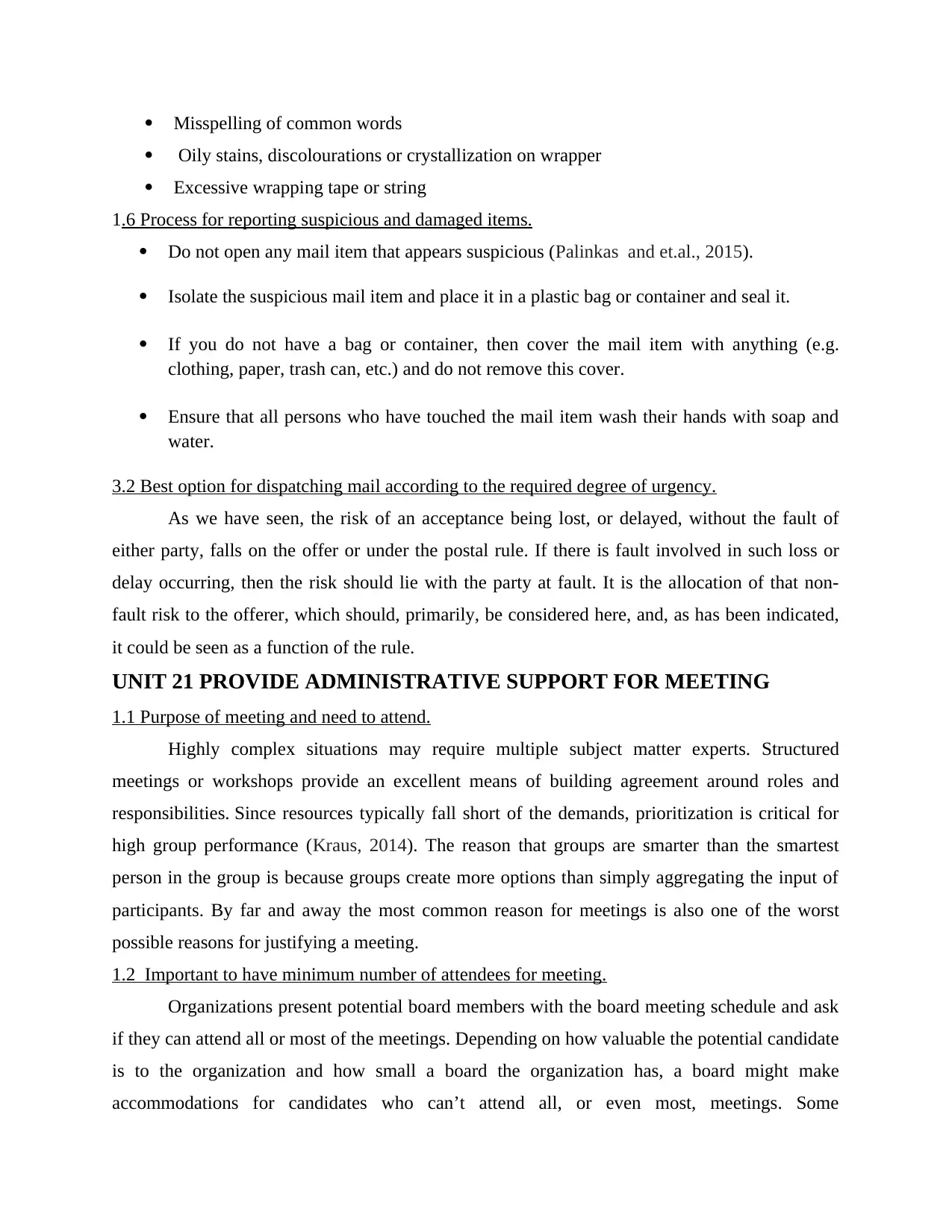
Misspelling of common words
Oily stains, discolourations or crystallization on wrapper
Excessive wrapping tape or string
1.6 Process for reporting suspicious and damaged items.
Do not open any mail item that appears suspicious (Palinkas and et.al., 2015).
Isolate the suspicious mail item and place it in a plastic bag or container and seal it.
If you do not have a bag or container, then cover the mail item with anything (e.g.
clothing, paper, trash can, etc.) and do not remove this cover.
Ensure that all persons who have touched the mail item wash their hands with soap and
water.
3.2 Best option for dispatching mail according to the required degree of urgency.
As we have seen, the risk of an acceptance being lost, or delayed, without the fault of
either party, falls on the offer or under the postal rule. If there is fault involved in such loss or
delay occurring, then the risk should lie with the party at fault. It is the allocation of that non-
fault risk to the offerer, which should, primarily, be considered here, and, as has been indicated,
it could be seen as a function of the rule.
UNIT 21 PROVIDE ADMINISTRATIVE SUPPORT FOR MEETING
1.1 Purpose of meeting and need to attend.
Highly complex situations may require multiple subject matter experts. Structured
meetings or workshops provide an excellent means of building agreement around roles and
responsibilities. Since resources typically fall short of the demands, prioritization is critical for
high group performance (Kraus, 2014). The reason that groups are smarter than the smartest
person in the group is because groups create more options than simply aggregating the input of
participants. By far and away the most common reason for meetings is also one of the worst
possible reasons for justifying a meeting.
1.2 Important to have minimum number of attendees for meeting.
Organizations present potential board members with the board meeting schedule and ask
if they can attend all or most of the meetings. Depending on how valuable the potential candidate
is to the organization and how small a board the organization has, a board might make
accommodations for candidates who can’t attend all, or even most, meetings. Some
Oily stains, discolourations or crystallization on wrapper
Excessive wrapping tape or string
1.6 Process for reporting suspicious and damaged items.
Do not open any mail item that appears suspicious (Palinkas and et.al., 2015).
Isolate the suspicious mail item and place it in a plastic bag or container and seal it.
If you do not have a bag or container, then cover the mail item with anything (e.g.
clothing, paper, trash can, etc.) and do not remove this cover.
Ensure that all persons who have touched the mail item wash their hands with soap and
water.
3.2 Best option for dispatching mail according to the required degree of urgency.
As we have seen, the risk of an acceptance being lost, or delayed, without the fault of
either party, falls on the offer or under the postal rule. If there is fault involved in such loss or
delay occurring, then the risk should lie with the party at fault. It is the allocation of that non-
fault risk to the offerer, which should, primarily, be considered here, and, as has been indicated,
it could be seen as a function of the rule.
UNIT 21 PROVIDE ADMINISTRATIVE SUPPORT FOR MEETING
1.1 Purpose of meeting and need to attend.
Highly complex situations may require multiple subject matter experts. Structured
meetings or workshops provide an excellent means of building agreement around roles and
responsibilities. Since resources typically fall short of the demands, prioritization is critical for
high group performance (Kraus, 2014). The reason that groups are smarter than the smartest
person in the group is because groups create more options than simply aggregating the input of
participants. By far and away the most common reason for meetings is also one of the worst
possible reasons for justifying a meeting.
1.2 Important to have minimum number of attendees for meeting.
Organizations present potential board members with the board meeting schedule and ask
if they can attend all or most of the meetings. Depending on how valuable the potential candidate
is to the organization and how small a board the organization has, a board might make
accommodations for candidates who can’t attend all, or even most, meetings. Some
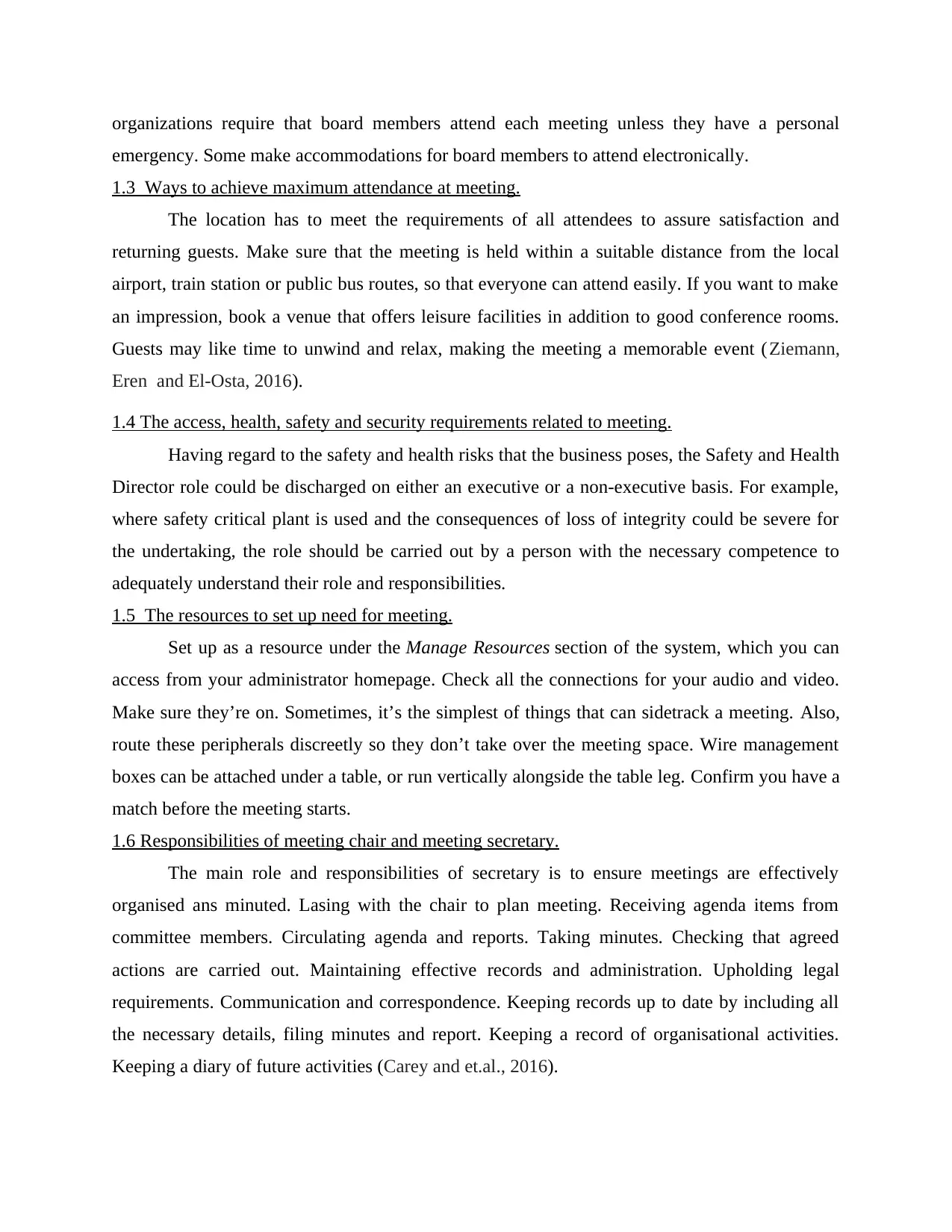
organizations require that board members attend each meeting unless they have a personal
emergency. Some make accommodations for board members to attend electronically.
1.3 Ways to achieve maximum attendance at meeting.
The location has to meet the requirements of all attendees to assure satisfaction and
returning guests. Make sure that the meeting is held within a suitable distance from the local
airport, train station or public bus routes, so that everyone can attend easily. If you want to make
an impression, book a venue that offers leisure facilities in addition to good conference rooms.
Guests may like time to unwind and relax, making the meeting a memorable event ( Ziemann,
Eren and El-Osta, 2016).
1.4 The access, health, safety and security requirements related to meeting.
Having regard to the safety and health risks that the business poses, the Safety and Health
Director role could be discharged on either an executive or a non-executive basis. For example,
where safety critical plant is used and the consequences of loss of integrity could be severe for
the undertaking, the role should be carried out by a person with the necessary competence to
adequately understand their role and responsibilities.
1.5 The resources to set up need for meeting.
Set up as a resource under the Manage Resources section of the system, which you can
access from your administrator homepage. Check all the connections for your audio and video.
Make sure they’re on. Sometimes, it’s the simplest of things that can sidetrack a meeting. Also,
route these peripherals discreetly so they don’t take over the meeting space. Wire management
boxes can be attached under a table, or run vertically alongside the table leg. Confirm you have a
match before the meeting starts.
1.6 Responsibilities of meeting chair and meeting secretary.
The main role and responsibilities of secretary is to ensure meetings are effectively
organised ans minuted. Lasing with the chair to plan meeting. Receiving agenda items from
committee members. Circulating agenda and reports. Taking minutes. Checking that agreed
actions are carried out. Maintaining effective records and administration. Upholding legal
requirements. Communication and correspondence. Keeping records up to date by including all
the necessary details, filing minutes and report. Keeping a record of organisational activities.
Keeping a diary of future activities (Carey and et.al., 2016).
emergency. Some make accommodations for board members to attend electronically.
1.3 Ways to achieve maximum attendance at meeting.
The location has to meet the requirements of all attendees to assure satisfaction and
returning guests. Make sure that the meeting is held within a suitable distance from the local
airport, train station or public bus routes, so that everyone can attend easily. If you want to make
an impression, book a venue that offers leisure facilities in addition to good conference rooms.
Guests may like time to unwind and relax, making the meeting a memorable event ( Ziemann,
Eren and El-Osta, 2016).
1.4 The access, health, safety and security requirements related to meeting.
Having regard to the safety and health risks that the business poses, the Safety and Health
Director role could be discharged on either an executive or a non-executive basis. For example,
where safety critical plant is used and the consequences of loss of integrity could be severe for
the undertaking, the role should be carried out by a person with the necessary competence to
adequately understand their role and responsibilities.
1.5 The resources to set up need for meeting.
Set up as a resource under the Manage Resources section of the system, which you can
access from your administrator homepage. Check all the connections for your audio and video.
Make sure they’re on. Sometimes, it’s the simplest of things that can sidetrack a meeting. Also,
route these peripherals discreetly so they don’t take over the meeting space. Wire management
boxes can be attached under a table, or run vertically alongside the table leg. Confirm you have a
match before the meeting starts.
1.6 Responsibilities of meeting chair and meeting secretary.
The main role and responsibilities of secretary is to ensure meetings are effectively
organised ans minuted. Lasing with the chair to plan meeting. Receiving agenda items from
committee members. Circulating agenda and reports. Taking minutes. Checking that agreed
actions are carried out. Maintaining effective records and administration. Upholding legal
requirements. Communication and correspondence. Keeping records up to date by including all
the necessary details, filing minutes and report. Keeping a record of organisational activities.
Keeping a diary of future activities (Carey and et.al., 2016).
⊘ This is a preview!⊘
Do you want full access?
Subscribe today to unlock all pages.

Trusted by 1+ million students worldwide
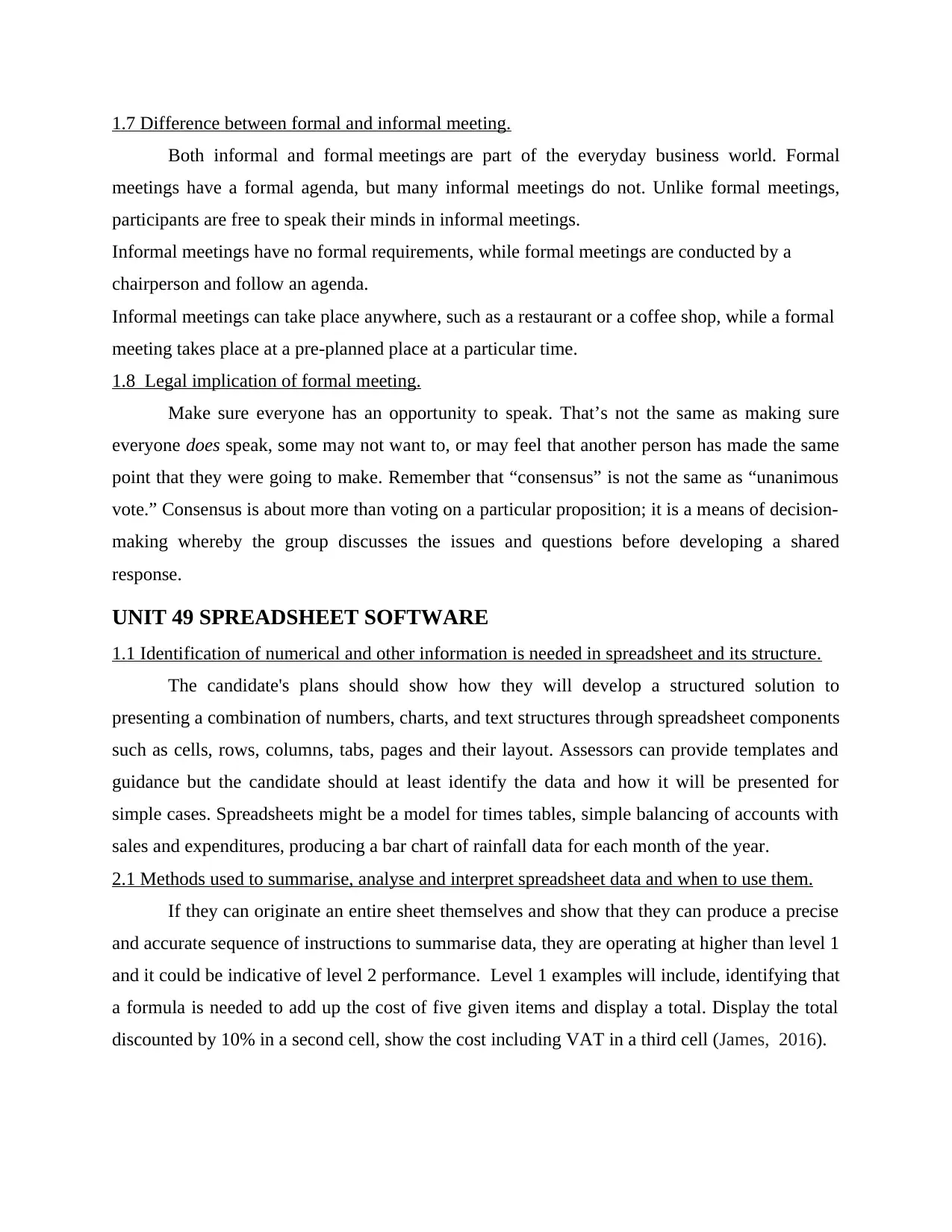
1.7 Difference between formal and informal meeting.
Both informal and formal meetings are part of the everyday business world. Formal
meetings have a formal agenda, but many informal meetings do not. Unlike formal meetings,
participants are free to speak their minds in informal meetings.
Informal meetings have no formal requirements, while formal meetings are conducted by a
chairperson and follow an agenda.
Informal meetings can take place anywhere, such as a restaurant or a coffee shop, while a formal
meeting takes place at a pre-planned place at a particular time.
1.8 Legal implication of formal meeting.
Make sure everyone has an opportunity to speak. That’s not the same as making sure
everyone does speak, some may not want to, or may feel that another person has made the same
point that they were going to make. Remember that “consensus” is not the same as “unanimous
vote.” Consensus is about more than voting on a particular proposition; it is a means of decision-
making whereby the group discusses the issues and questions before developing a shared
response.
UNIT 49 SPREADSHEET SOFTWARE
1.1 Identification of numerical and other information is needed in spreadsheet and its structure.
The candidate's plans should show how they will develop a structured solution to
presenting a combination of numbers, charts, and text structures through spreadsheet components
such as cells, rows, columns, tabs, pages and their layout. Assessors can provide templates and
guidance but the candidate should at least identify the data and how it will be presented for
simple cases. Spreadsheets might be a model for times tables, simple balancing of accounts with
sales and expenditures, producing a bar chart of rainfall data for each month of the year.
2.1 Methods used to summarise, analyse and interpret spreadsheet data and when to use them.
If they can originate an entire sheet themselves and show that they can produce a precise
and accurate sequence of instructions to summarise data, they are operating at higher than level 1
and it could be indicative of level 2 performance. Level 1 examples will include, identifying that
a formula is needed to add up the cost of five given items and display a total. Display the total
discounted by 10% in a second cell, show the cost including VAT in a third cell (James, 2016).
Both informal and formal meetings are part of the everyday business world. Formal
meetings have a formal agenda, but many informal meetings do not. Unlike formal meetings,
participants are free to speak their minds in informal meetings.
Informal meetings have no formal requirements, while formal meetings are conducted by a
chairperson and follow an agenda.
Informal meetings can take place anywhere, such as a restaurant or a coffee shop, while a formal
meeting takes place at a pre-planned place at a particular time.
1.8 Legal implication of formal meeting.
Make sure everyone has an opportunity to speak. That’s not the same as making sure
everyone does speak, some may not want to, or may feel that another person has made the same
point that they were going to make. Remember that “consensus” is not the same as “unanimous
vote.” Consensus is about more than voting on a particular proposition; it is a means of decision-
making whereby the group discusses the issues and questions before developing a shared
response.
UNIT 49 SPREADSHEET SOFTWARE
1.1 Identification of numerical and other information is needed in spreadsheet and its structure.
The candidate's plans should show how they will develop a structured solution to
presenting a combination of numbers, charts, and text structures through spreadsheet components
such as cells, rows, columns, tabs, pages and their layout. Assessors can provide templates and
guidance but the candidate should at least identify the data and how it will be presented for
simple cases. Spreadsheets might be a model for times tables, simple balancing of accounts with
sales and expenditures, producing a bar chart of rainfall data for each month of the year.
2.1 Methods used to summarise, analyse and interpret spreadsheet data and when to use them.
If they can originate an entire sheet themselves and show that they can produce a precise
and accurate sequence of instructions to summarise data, they are operating at higher than level 1
and it could be indicative of level 2 performance. Level 1 examples will include, identifying that
a formula is needed to add up the cost of five given items and display a total. Display the total
discounted by 10% in a second cell, show the cost including VAT in a third cell (James, 2016).
Paraphrase This Document
Need a fresh take? Get an instant paraphrase of this document with our AI Paraphraser

3.1 Explain how to present and format spreadsheet information effectively to meet needs.
It should be well-defined and routine with appropriate guidance. If they plan and develop
structured solutions to problems, combining several spreadsheet tools and techniques, ensuring
appropriate presentation, they are operating higher than the required level. They should be
aiming to include use of numbers, currency, percentages, number of decimal places, font and
alignment, borders and shading, height, width, borders and shading. Self-sufficiency in a wide
range of formatting to produce clear and attractive presentations of data indicates Higher
performance.
UNIT 52 USING E- MAIL
1.2 Explain methods to improve message transmission.
The difference between double and single opt-in is that with double opt-in also called
confirmed opt-in, people get a confirmation email after they’ve entered their email address into
your form and clicked submit. A hard bounce is when an email message is sent to an email
account that is closed or no longer exists. Over-mailing is also a little trickier to blame for poor
deliver ability rates, because when you send more emails, people tend to respond less
1.4 How to stay safe and respect other using e-mail.
To protect your email account from hackers it is important to choose a strong password.
The most secure password are at least 7-8 characters and use at least one of each of the following
characters: an uppercase letter, a lowercase letter, a number, and a special character (such
as !, @, or $). . Most anti-virus programs today have a scanner that can scan every inbound and
outbound mail for any potential threats that can be contained within a message or its
attachment(s).
2.4 Why, how, to stay safe and respect others when using e- mail.
The ones requiring the user to send to x number of people within x number of hours or
something bad is going to happen is definitely malicious in nature. Avoid them if you can and
stop forwarding them to other people. These messages will inform you that someone extremely
rich and who you’ve never ever met or even heard of is willing to give you a lot of money simply
for helping him/her. Wow, it sounds good (Bush, Bell and Middlewood, 2010).
It should be well-defined and routine with appropriate guidance. If they plan and develop
structured solutions to problems, combining several spreadsheet tools and techniques, ensuring
appropriate presentation, they are operating higher than the required level. They should be
aiming to include use of numbers, currency, percentages, number of decimal places, font and
alignment, borders and shading, height, width, borders and shading. Self-sufficiency in a wide
range of formatting to produce clear and attractive presentations of data indicates Higher
performance.
UNIT 52 USING E- MAIL
1.2 Explain methods to improve message transmission.
The difference between double and single opt-in is that with double opt-in also called
confirmed opt-in, people get a confirmation email after they’ve entered their email address into
your form and clicked submit. A hard bounce is when an email message is sent to an email
account that is closed or no longer exists. Over-mailing is also a little trickier to blame for poor
deliver ability rates, because when you send more emails, people tend to respond less
1.4 How to stay safe and respect other using e-mail.
To protect your email account from hackers it is important to choose a strong password.
The most secure password are at least 7-8 characters and use at least one of each of the following
characters: an uppercase letter, a lowercase letter, a number, and a special character (such
as !, @, or $). . Most anti-virus programs today have a scanner that can scan every inbound and
outbound mail for any potential threats that can be contained within a message or its
attachment(s).
2.4 Why, how, to stay safe and respect others when using e- mail.
The ones requiring the user to send to x number of people within x number of hours or
something bad is going to happen is definitely malicious in nature. Avoid them if you can and
stop forwarding them to other people. These messages will inform you that someone extremely
rich and who you’ve never ever met or even heard of is willing to give you a lot of money simply
for helping him/her. Wow, it sounds good (Bush, Bell and Middlewood, 2010).
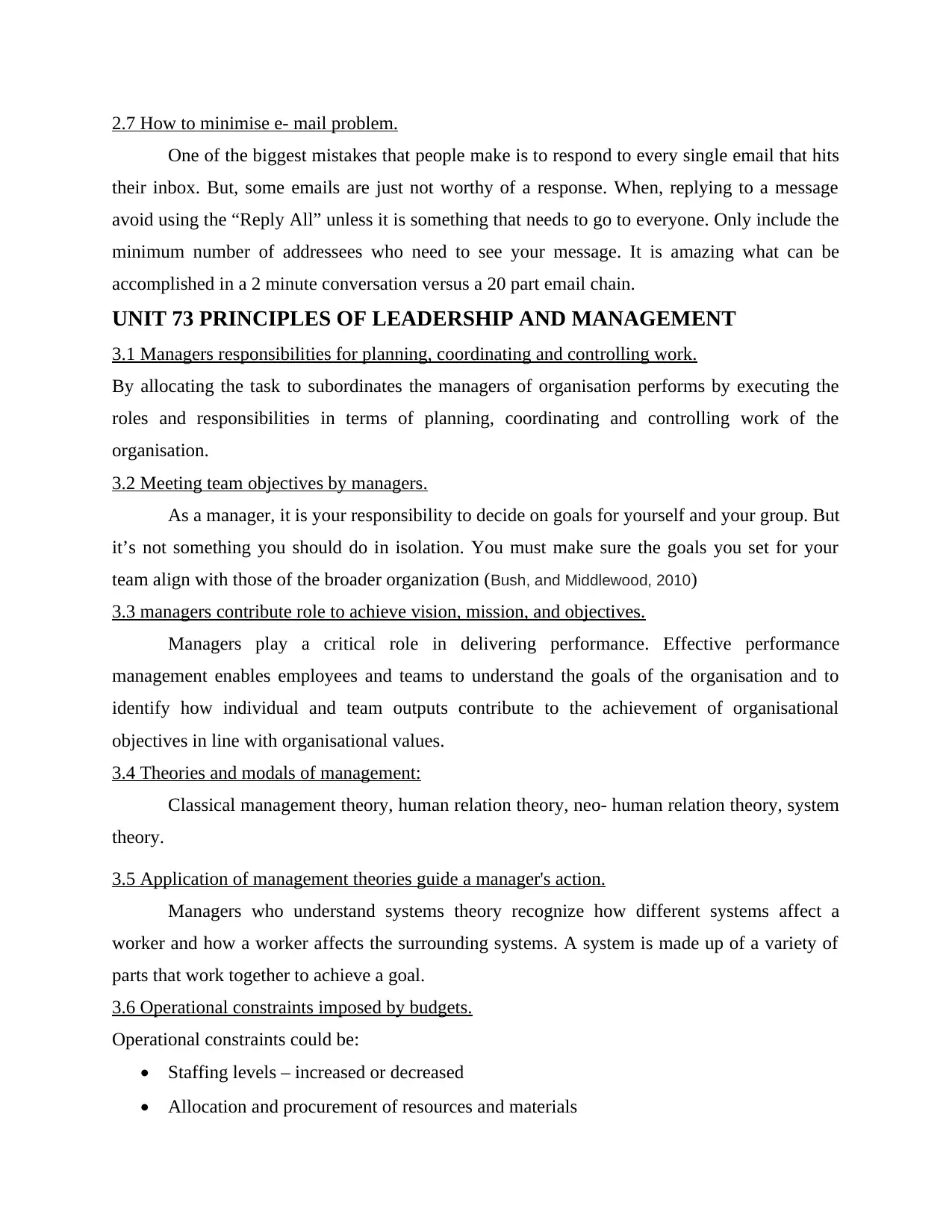
2.7 How to minimise e- mail problem.
One of the biggest mistakes that people make is to respond to every single email that hits
their inbox. But, some emails are just not worthy of a response. When, replying to a message
avoid using the “Reply All” unless it is something that needs to go to everyone. Only include the
minimum number of addressees who need to see your message. It is amazing what can be
accomplished in a 2 minute conversation versus a 20 part email chain.
UNIT 73 PRINCIPLES OF LEADERSHIP AND MANAGEMENT
3.1 Managers responsibilities for planning, coordinating and controlling work.
By allocating the task to subordinates the managers of organisation performs by executing the
roles and responsibilities in terms of planning, coordinating and controlling work of the
organisation.
3.2 Meeting team objectives by managers.
As a manager, it is your responsibility to decide on goals for yourself and your group. But
it’s not something you should do in isolation. You must make sure the goals you set for your
team align with those of the broader organization (Bush, and Middlewood, 2010)
3.3 managers contribute role to achieve vision, mission, and objectives.
Managers play a critical role in delivering performance. Effective performance
management enables employees and teams to understand the goals of the organisation and to
identify how individual and team outputs contribute to the achievement of organisational
objectives in line with organisational values.
3.4 Theories and modals of management:
Classical management theory, human relation theory, neo- human relation theory, system
theory.
3.5 Application of management theories guide a manager's action.
Managers who understand systems theory recognize how different systems affect a
worker and how a worker affects the surrounding systems. A system is made up of a variety of
parts that work together to achieve a goal.
3.6 Operational constraints imposed by budgets.
Operational constraints could be:
• Staffing levels – increased or decreased
• Allocation and procurement of resources and materials
One of the biggest mistakes that people make is to respond to every single email that hits
their inbox. But, some emails are just not worthy of a response. When, replying to a message
avoid using the “Reply All” unless it is something that needs to go to everyone. Only include the
minimum number of addressees who need to see your message. It is amazing what can be
accomplished in a 2 minute conversation versus a 20 part email chain.
UNIT 73 PRINCIPLES OF LEADERSHIP AND MANAGEMENT
3.1 Managers responsibilities for planning, coordinating and controlling work.
By allocating the task to subordinates the managers of organisation performs by executing the
roles and responsibilities in terms of planning, coordinating and controlling work of the
organisation.
3.2 Meeting team objectives by managers.
As a manager, it is your responsibility to decide on goals for yourself and your group. But
it’s not something you should do in isolation. You must make sure the goals you set for your
team align with those of the broader organization (Bush, and Middlewood, 2010)
3.3 managers contribute role to achieve vision, mission, and objectives.
Managers play a critical role in delivering performance. Effective performance
management enables employees and teams to understand the goals of the organisation and to
identify how individual and team outputs contribute to the achievement of organisational
objectives in line with organisational values.
3.4 Theories and modals of management:
Classical management theory, human relation theory, neo- human relation theory, system
theory.
3.5 Application of management theories guide a manager's action.
Managers who understand systems theory recognize how different systems affect a
worker and how a worker affects the surrounding systems. A system is made up of a variety of
parts that work together to achieve a goal.
3.6 Operational constraints imposed by budgets.
Operational constraints could be:
• Staffing levels – increased or decreased
• Allocation and procurement of resources and materials
⊘ This is a preview!⊘
Do you want full access?
Subscribe today to unlock all pages.

Trusted by 1+ million students worldwide
1 out of 16
Related Documents
Your All-in-One AI-Powered Toolkit for Academic Success.
+13062052269
info@desklib.com
Available 24*7 on WhatsApp / Email
![[object Object]](/_next/static/media/star-bottom.7253800d.svg)
Unlock your academic potential
Copyright © 2020–2025 A2Z Services. All Rights Reserved. Developed and managed by ZUCOL.





